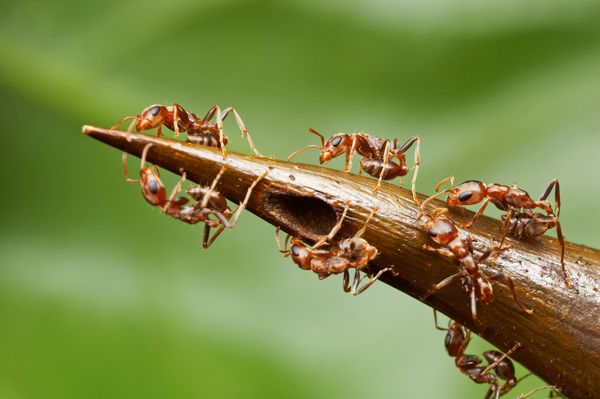Trees Trap Ants Into Sweet Servitude
An enzyme in the nectar of acacia trees makes ants chemically dependent on their sugar.
An evolutionary alliance between trees and the ants that guard them has a sinister explanation, a new study suggests, finding ants hooked on nectar.
In Central America, ants act as bodyguards for acacia trees, defending them from weeds and hungry animals in exchange for room and board, one of the most iconic alliances in nature.
But Martin Heil of Cinvestav Unidad Irapuato in Mexico has found that the tree's sugary snacks are laced with an enzyme that prevents the ants from eating other sources of sugar.
One sip, and the insects are consigned to a life of indentured servitude.
"It was surprising to me that the immobile, 'passive' plant can manipulate the seemingly much more active partner, the ant," says Heil.
The report illustrates how evolution keeps cooperative relationships among some species going, even when one partner is clearly reaping most of the benefits in the arrangement.
Nectar Addicts
Heil compares the tree to a dairy company that sells lactose-free milk that has been chemically altered to render its customers unable to digest normal milk. Any customer who drank it would be forced to stick to that one lactose-free brand.
Here's how it works. Most of the sweet foods that ants eat, such as plant sap, are rich in a sugar called sucrose. The ants digest this with an enzyme called invertase, which breaks sucrose into smaller sugars.
In 2005, Heil showed that all of the workers of the acacia ant Pseudomyrmex ferrugineus lack invertase activity and cannot digest normal sources of sucrose.
Fortunately, the tree compensates for this impairment by secreting invertase into its nectar, providing the ants with a predigested meal. For this reason, the ants prefer acacia nectar over other sugar sources.
But Heil suspected that this explanation was too neat. Why would the ants so heavily restrict their dietary options by losing an important enzyme?
Weirder still, in 2008, Heil showed that the larvae have invertase, which becomes deactivated only when they turn into adults.
Culprit Nabbed
Heil has now shown that the tree itself is responsible. Writing in the Ecology Letters journal, he reports that acacia nectar contains chitinase enzymes that completely block invertase.
Shortly after the workers emerge from their pupae as adults, they take their first sip of nectar and their invertase becomes irreversibly disabled.
"Ain't nature grand?" says Todd Palmer of the University of Florida, who studies ants and acacias.
"What looks from the outside as another case of digestive specialization appears to be a sneaky manipulation on the part of the acacia to increase ant dependence."
Bodyguard Biochemistry
Heil now wants to work out how a plant's chitinase could block an ant's invertase.
"All the biochemists whom I talked to told me that there is no way one of these enzymes can inhibit the other. There is simply no known biochemical mechanism through which this could happen," he says.
"It adds to our understanding of why co-evolved systems persist even when they may not be required for both partners," says Corrie Moreau, an evolutionary biologist from the Field Museum in Chicago.
In this case, the tree's manipulation ensures that the ants are driven to defend it, since it is their only source of digestible food. Their fates become tied to their effectiveness as bodyguards.
But Moreau wonders why the larvae and the newly emerged adults do not branch out to other food sources, since their invertase is yet to be deactivated.
Heil thinks this is because nectar is almost always their first adult meal, either because it is the closest food or because the ants are fed the nectar by their nest-mates.
"Since the first dose of nectar is enough to reduce invertase activity, they remain trapped," he says.
Potemkin Partnerships
"We hope that this will change the way in which we understand mutualism in general," adds Heil.
There are other examples where two-way partnerships are more biased than they first appear. Ecologists have wondered whether some flowers dope their nectar with addictive chemicals, to prevent their pollinators from visiting other plants.
Similarly, some bacteria provide trees with nutrients by forming nodules on their roots—this is often seen as a partnership, but since the bacteria can no longer divide or move, you could view them as the tree's slaves.
"Partner manipulation might play a role in many different types of mutualisms," says Heil.
Ed Yong
for National Geographic
Published November 6, 2013












